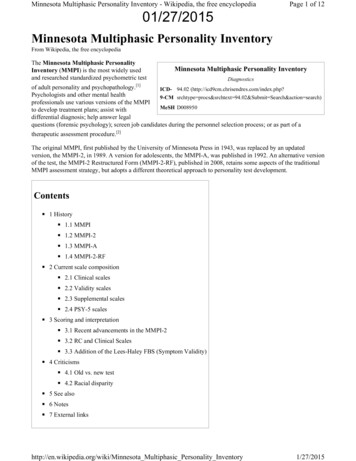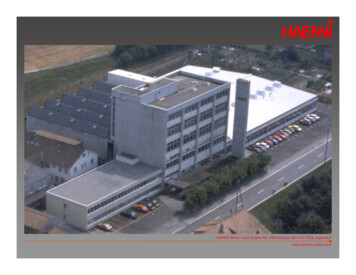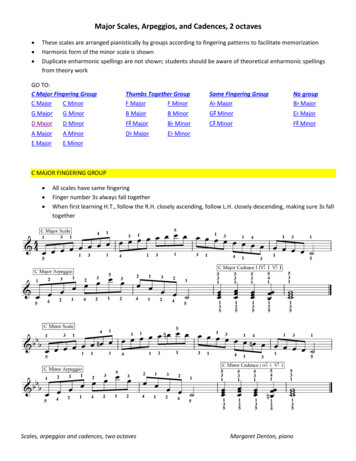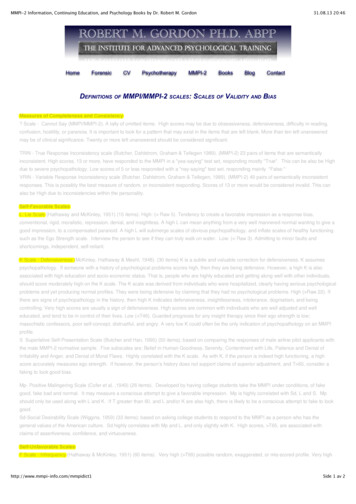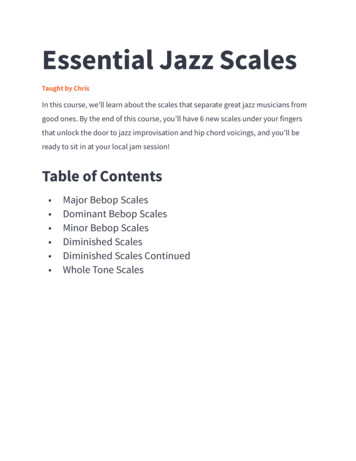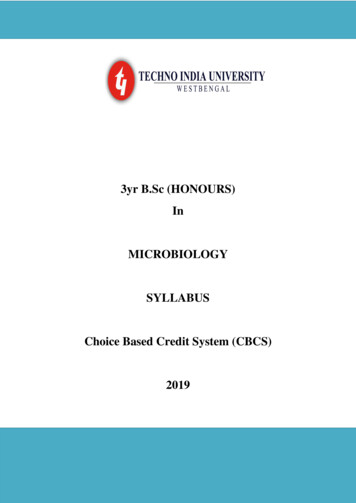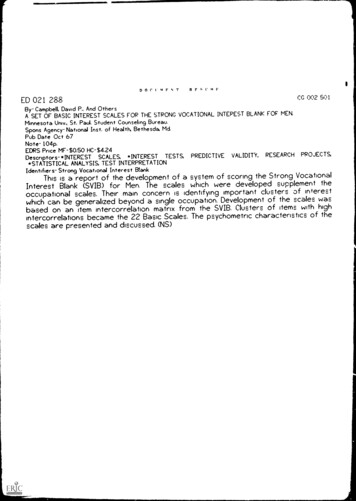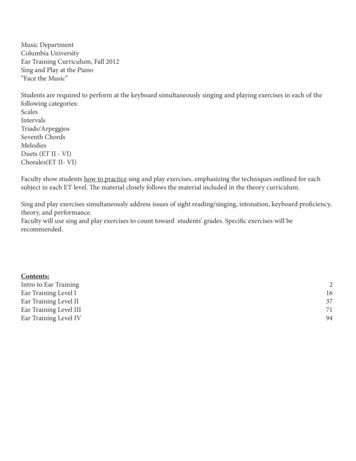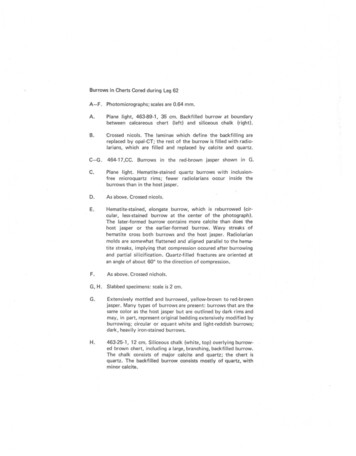
Transcription
Burrows in Cherts Cored during Leg 62A—F. Photomicrographs; scales are 0.64 mm.A.Plane light, 463-89-1, 35 cm. Backfilled burrow at boundarybetween calcareous chert (left) and siliceous chalk (right).B.Crossed nicols. The laminae which define the backfilling arereplaced by opal-CT; the rest of the burrow is filled with radiolarians, which are filled and replaced by calcite and quartz.C—G. 464-17,CC. Burrows in the red-brown jasper shown in G.C.Plane light. Hematite-stained quartz burrows with inclusionfree microquartz rims; fewer radiolarians occur inside theburrows than in the host jasper.D.As above. Crossed nicols.E.Hematite-stained, elongate burrow, which is reburrowed (circular, less-stained burrow at the center of the photograph).The later-formed burrow contains more calcite than does thehost jasper or the earlier-formed burrow. Wavy streaks ofhematite cross both burrows and the host jasper. Radiolarianmolds are somewhat flattened and aligned parallel to the hematite streaks, implying that compression occured after burrowingand partial silicification. Quartz-filled fractures are oriented atan angle of about 60 to the direction of compression.F.As above. Crossed nichols.G. H. Slabbed specimens: scale is 2 cm.G.Extensively mottled and burrowed, yellow-brown to red-brownjasper. Many types of burrows are present: burrows that are thesame color as the host jasper but are outlined by dark rims andmay, in part, represent original bedding extensively modified byburrowing; circular or equant white and light-reddish burrows;dark, heavily iron-stained burrows.H.463-25-1, 12 cm. Siliceous chalk (white, top) overlying burrowed brown chert, including a large, branching, backfilled burrow.The chalk consists of major calcite and quartz; the chert isquartz. The backfilled burrow consists mostly of quartz, withminor calcite.
Initial Reportsof theDeep Sea Drilling ProjectA Project Planned By and Carried Out With the Advice of theJOINT OCEANOGRAPHIC INSTITUTIONS FOR DEEP EARTH SAMPLING (JOIDES)VOLUME LXIIcovering Leg 62 of the cruises of the Drilling Vessel Glomar ChallengerMarjuro Atoll, Marshall Islands to Honolulu, HawaiiJuly-September 1978PARTICIPATING SCIENTISTSJörn Thiede, Tracy L. Valuer,Charles G. Adelseck, Anne Boersma, Pavel Cepek,Walter E. Dean, Naoyuki Fujii, Vladimir I. Koporulin, David K. Rea,Constance Sancetta, William O. Sayre, Karl Seifert,Andre Schaaf, Ronald R. Schmidt, Kenneth Windom,and Edith VincentSTAFF SCIENCE REPRESENTATIVECharles G. AdelseckEDITORLarry N. StoutPrepared for theNATIONAL SCIENCE FOUNDATIONNational Ocean Sediment Coring ProgramUnder Contract C-482By theUNIVERSITY OF CALIFORNIAScripps Institution of OceanographyPrime Contractor for the Project
This material is based upon research supported by the NationalScience Foundation under Contract No. C-482.Any opinions, findings, and conclusions or recommendations expressed in this publication are those of the author(s) and do notnecessarily reflect the views of the National Science Foundation.It is recommended that reference to the whole or to part of thisvolume be made in one of the following forms, as appropriate:Thiede, J., Valuer, T. L., et al., 1981. Init. Repts. DSDP, 62:Washington (U.S. Govt. Printing Office).Sancetta, C. A., 1981. Neogene diatoms from Deep Sea DrillingProject Leg 62. In Thiede, J., Valuer, T. L., et al., Init. Repts.DSDP, 62: Washington (U.S. Govt. Printing Office), 355-360.Effective Publication Dates of DSDP Initial ReportsAccording to the International Code of Zoological Nomenclature, the date ofpublication of a work and of a contained name or statement affecting nomenclatureis the date on which the publication was mailed to subscribers, placed on sale, or,when the whole edition is distributed free of charge, mailed to institutions and individuals to whom free copies are distributed. The mailing date, not the printeddate, is the correct one.Mailing dates of the more recent Initial Reports of the Deep Sea Drilling Projectare as follows:Volume 54—December, 1980Volume 55—September, 1980Volume 56, 57—Part 1, November, 1980Part 2, November, 1980Volume 58—August, 1980Volume 59—January, 1981Printed November 1981Library of Congress Catalog Number 74—603338For sale by the Superintendent of Documents, U.S. Government Printing OfficeWashington, D.C. 20402IV
- —-,-jJF O r β W O r QBetween 1872 and 1876, the H.M.S. CHALLENGER undertook the world's first majoroceanographic expedition. That expedition greatlyexpanded man's knowledge of the world's oceansand revolutionized his ideas about this planet earth.A century later, over the course of the past decade,another vessel, also named CHALLENGER,has continued to expand man's knowledge of theworld ocean, and has revolutionized his conceptsof how the seafloor and continents were formedand continue to change. The D/V GLOMARCHALLENGER is plying the same waters as itshistoric counterpart, seeking answers to new questions concerning the history of our planet andthe life it supports. The continued advancementof knowledge about the fundamental processesand dynamics of the earth will lead to a greaterunderstanding of our planet and more intelligentuse of its resources.Since 1968, the Deep Sea Drilling Project hasbeen supported by the National Science Foundation, primarily through a contract with theUniversity of California which, in turn, subcontracts to Global Marine Incorporated for theservices of the drillship D/V GLOMAR CHALLENGER. Scripps Institution of Oceanographyis responsible for management of the Universitycontract.Through contracts with Joint OceanographicInstitutions, Inc. (JOI, Inc.), the National ScienceFoundation supports the scientific advisory structure for the project and funds some pre-drillingsite surveys. Scientific planning is conducted underthe auspices of the Joint Oceanographic Institutions for Deep Earth Sampling (JOIDES). TheJOIDES advisory group consists of over 250members who make up 24 committees, panels orworking groups. The members are distinguishedscientists from academic institutions, governmentagencies and private industry in many countries.In 1975, the International Phase of OceanDrilling (IPOD) began. IPOD member nations,USSR, Federal Republic of Germany, Japan,United Kingdom and France, provide partialsupport of the project. Each member nation takesan active role in the scientific planning of theproject through organization membership inJOIDES. Scientists from these countries alsoparticipate in the field work aboard the D/V
GLOMAR CHALLENGER and post-cruisescientific studies.The first ocean coring operations for the DeepSea Drilling Project began on August 11, 1968.During the ensuing years of drilling operationsin the Atlantic, Pacific and Indian Oceans, theGulf of Mexico, Caribbean Sea, MediterraneanSea, and Antarctic waters, the scientific objectives that had been proposed were successfullyaccomplished. Primarily, the age of the oceanbasins and their processes of development weredetermined. The validity of the hypothesis of seafloor spreading was firmly demonstrated and itsdynamics studied. Emphasis was placed on broadreconnaissance and testing the involvement of midoceanic ridge systems in the development of theocean basin. Later legs of the CHALLENGERSvoyages concentrated on the nature of the oceaniccrust, the sedimentary history of the passive oceanmargins, sediment dynamics along active oceanmargins and other areas of interest. The accumulated results of this project have led to major newinterpretations of the pattern of sedimentationand the physical and chemical characteristicsof the ancient oceans.As a result of the continued success of the DeepSea Drilling Project, the National Science Foundation has presently extended the project throughfiscal year 1982. The latest contract extends theperiod of exploration of the deep ocean floorsof the world by GLOMAR CHALLENGER toa total of over 14 years.A new dimension of scientific discovery hasbeen added to the project, the detailed study ofpaleoenvironment. With the introduction of theVIhydraulic piston corer in 1979, virtually undisturbed cores of the soft sediment layers can nowbe obtained. This technological advance, togetherwith the new pressure core barrel, has greatlyenhanced the ability of the project to study ancientocean climates as recorded by the micro floraand fauna preserved in the sedimentary layers.These reports contain the results of initial studiesof the recovered core material and the associatedgeophysical information. The contribution toknowledge has been exceedingly large. Futurestudies of the core material over many years willcontribute much more.People of our planet, in their daily living andwork activities will benefit directly and/or indirectly from this research. Benefits are derivedfrom the technological advances in drilling, coring,position-keeping and other areas as well as throughthe information being obtained about naturalresources and their origins. As with the originalH.M.S. CHALLENGER oceanographic expedition, this second CHALLENGER expeditionwill have profound effects on scientific understanding for many years to come.John B. SlaughtDirectorWashington, D.C.June 1981
13.o r-*c -t I v3IcLOv3Recognizing the need in the oceanographiccommunity for scientific planning of a programto obtain deep sedimentary cores from theocean bottoms, four of the major oceanographic institutions that had strong interests and programs in the fields of marine geology and geophysics formed, in May 1964, the Joint Oceanographic Institututions for Deep Earth Sampling (JOIDES). This group—Lamont-DohertyGeological Observatory; Rosenstiel School ofMarine and Atmospheric Science, University ofMiami; the Scripps Institution of OceanograPhy University of California at San Diego; andthe Woods Hole Oceanographic Institution—expressed an interest in undertaking scientificplanning and guidance of the sedimentary drilling program. It was the purpose of this groupto foster programs to investigate the sedimentsand rocks beneath the deep oceans by drillingand coring. The membership of the originalgroup was later enlarged, in 1968 when theUniversity of Washington became a memberand again in 1975 when University of HawaiiInstitute of Geophysics, the Oregon State University School of Oceanography, the Universityof Rhode Island Graduate School of Oceanography, and Texas A&M University Departmentof Oceanography became members. In accordance with international agreements, institutionsof participating nations became members ofJOIDES. Thus, during 1974 to 1976, the Bundesanstalt für Geowissenschaften und Rohstoffeof the Federal Republic of Germany, the CentreNational pour PExploitation des Oceans ofFrance, the National Environmental ResearchCouncil of the United Kingdom, the Universityof Tokyo of Japan, and the Academy of Sciences of the USSR became JOIDES members.Through discussions sponsored by theJOIDES organization, with support from theNational Science Foundation, Columbia University Lamont-Doherty Geological Observatory operated a drilling program in the summer of 1965 on the Blake Plateau region offJacksonville, Florida.vn
With this success in hand, planning beganfor a more extensive deep sea effort. Thisresulted in the award of a contract by theNational Science Foundation to the Scripps Institution of Oceanography, University of California at San Diego for an eighteen-monthdrilling program in the Atlantic and Pacificoceans, termed the Deep Sea Drilling Project(DSDP). Operations at sea began in August1968, using the now-famous drilling vessel, theGlomar Challenger.The goal of the Deep Sea Drilling Projectis to gather scientific information that will helpdetermine the age and processes of development of the ocean basins. The primary strategyis to drill deep holes into the ocean floor, relying largely on technology developed by thepetroleum industry.Through the efforts of the principal organizations and of the panel members, whowere drawn from a large cross section of leading earth scientists and associates, a scientificprogram was developed.Cores recovered from deep beneath theocean floor provide reference material for amultitude of studies in fields such as biostratigraphy, physical stratigraphy, and Paleomagnetism that afford a new scope for investigatingthe physical and chemical aspects of sedimentprovenance, transportation, deposition, anddiagenesis. In-hole measurements, as feasible,provide petrophysical data to permit inferenceof lithology of intervals from which no coreswere recovered.A report, describing the core materials andinformation obtained both at sea and in laboratories onshore, is published after the completion of each cruise. These reports are acooperative effort of shipboard and shorebased scientists and are intended primarily to bea compilation of results which, it is hoped, willbe the starting point for many future new andexciting research programs. Preliminary interpretations of the data and observations taken atsea are also included.Core materials and data collected on eachcruise will be made available to qualified scientists through the Curator of the Deep Sea Drill-Vllling Project, following a Sample DistributionPolicy (p. xix) approved by the National Science Foundation.The advent of Glomar Challenger, with itsdeep-water drilling capability, is exceedinglytimely. It has come when geophysical investigation of the oceans has matured through 20 to 30years of vigorous growth to the point where wehave some knowledge about much of the formerly unknown oceanic areas of our planet.About one million miles of traverses have beenmade which tell us much about the global pattern of gravity, magnetic and thermal anomalies, and about the composition, thickness, andstratigraphy of the sedimentary cover of thedeep sea and continental margin. The coveragewith such data has enabled the site selectionpanels to pick choice locations for drilling. Theknowledge gained from each hole can be extended into the surrounding area. Detailed geophysical surveys were made for most of theselected locations prior to drilling.The earth sciences have recently maturedfrom an empirical status to one in which substantial theories and hypotheses about majortectonic processes are flourishing. Theoriesabout the origin of magnetic fields and magnetic reversals, about ocean floor spreading andcontinental drift, and about the thermal historyof our planet have led to specific predictionsthat could be tested best by an enlightened program of sampling of deep sea and continentalmargin sediments and underlying rocks.In October 1975, the International Phaseof Ocean Drilling (IPOD) began. This international interest, and the true participationof both the scientists and governments of anumber of nations, are eloquent testimony tothe importance of the work being done by theDeep Sea Drilling Project.The members of JOIDES and DSDP andthe scientists from all interested organizationsand nations who have served on the various advisory panels are proud to have been of serviceand believe that the information and core materials that have been obtained will be of valueto students of earth sciences and to all humanity for many years to come.
Deep SeaDrilling ProjectMEMBER ORGANIZATIONS OF THE JOINTOCEANOGRAPHIC INSTITUTIONS FORDEEP EARTH SAMPLING (JOIDES):*Bundesanstalt für Geowissenschaften und Rohstoffe,Federal Republic of GermanyUniversity of California at San Diego,Scripps Institution of OceanographyCentre National pour PExploitation des Oceans,ParisColumbia University, Lamont-Doherty GeologicalObservatoryUniversity of Hawaii, Hawaii Institute ofGeophysicsUniversity of Miami, Rosenstiel School ofMarine and Atmospheric ScienceNatural Environment Research Council,LondonOregon State University, School ofOceanographyUniversity of Rhode Island, GraduateSchool of OceanographyTexas A&M University, Department ofOceanographyUniversity of Tokyo, Ocean ResearchInstituteUniversity of Washington, Departmentof OceanographyU.S.S.R. Academy of SciencesWoods Hole Oceanographic Institution Includes member organizations duringtime of the cruise.OPERATING INSTITUTION:Scripps Institution of OceanographyUniversity of California at San DiegoLa Jolla, CaliforniaW. A. Nierenberg, DirectorDEEP SEA DRILLING PROJECTDr. W. A. NierenbergPrincipal InvestigatorDr. M. N. A. PetersonProject ManagerMr. Frank C. MacTernanPrincipal Engineer andDeputy Project ManagerDr. Yves LancelotChief ScientistDr. Matthew H. SalisburyAssociate Chief Scientist forScience OperationsDr. William R. RiedelCuratorMr. Stanley T. SerockiProject Development EngineerMr. Barry RobsonOperations ManagerMr. William T. SoderstromFinance AdministratorMr. Robert OlivasLogistics OfficerMr. Robert S. BowerContracts OfficerMs. Sue StrainPersonnel OfficerIX
Participants aboardGLOMAR CHALLENGER for Leg:Dr. Jörn ThiedeCo-Chief ScientistDepartment of GeologyUniversity of OsloP.O. Box 1047Blindern, Oslo 3NorwayDr. Tracy L. ValuerCo-Chief ScientistU.S. Geological Survey345 Middlefield RoadMenlo Park, California 94025Dr. Charles G. AdelseckSedimentologist and ShipboardScience RepresentativeDeep Sea Drilling Project, A-031Scripps Institution of OceanographyLa Jolla, California 92093Dr. Anne BoersmaPaleontologist (foraminifers)Lamont-Doherty Geological ObservatoryColumbia UniversityPalisades, New York 10964Dr. Pavel CepekPaleontologist (nannofossils)Bundesanstalt fur Geowissenschaftenund RohstoffePostfach 5101533 Hannover 51Federal Republic of GermanyDr. Walter E. DeanSedimentologistU.S. Geological SurveyP.O. Box 25046, Mail Stop 925Denver, Colorado 80225Dr. Naoyuki FujiiPhysical Properties SpecialistDepartment of Earth SciencesKobe UniversityNada, Kobe, 657JapanDr. Vladimir I. KoporulinSedimentologistGeological InstituteU.S.S.R. Academy of SciencesPyzhevskiy pereulok 7109017 Moscow Zh-17U.S.S.R.Sixty-twoDr. David K. ReaSedimentologist and GeophysicistDepartmen t of Atm osphericand Oceanic SciencesUniversity of MichiganSpace Research Building2455 HaywardAnn Arbor, Michigan 48109Dr. Constance SancettaPaleontologist (diatoms)Department of GeologyStanford UniversityStanford, California 94305Mr. William O. SayrePaleomagnetistDepartment of OceanographyUniversity of SouthamptonSouthampton SO9 5NHUnited KingdomDr. Karl SeifertIgneous PetrologistDepartment of Earth SciencesIowa State University of Scienceand TechnologyAmes, Iowa 50011Dr. Andre SchaafPaleontologist (radiolarians)Institut de Géologie1, rue Blessig67084 Strasbourg, CedexFranceDr. Ronald R. SchmidtPaleontologist (nannofossils)Institute of Earth SciencesBudapestiaan 4P.O. Box 80.0213508 TA UtrechtThe NetherlandsDr. Edith VincentPaleontologist (foraminifers)Scripps Institution of Oceanography, A-015La Jolla, California 92093XI
Dr. Kenneth E. WindomIgneous PetrologistDepartment of Earth SciencesIowa State University of Scienceand TechnologyAmes, Iowa 50011Mr. Robert R. KnappCruise Operations ManagerDeep Sea Drilling Project, A-031Scripps Institution of OceanographyLa Jolla, California 92093Mr. Robert ConnollyWeathermanNational Weather ServiceNational Oceanic and Atmospheric AdministrationDeep Sea Drilling Project, A-031Scripps Institution of OceanographyLa Jolla, California 92093Captain Loyd DillCaptain of the Drilling VesselGlobal Marine, Inc.Los Angeles, California 90017Mr. Otis WintonDrilling SuperintendentGlobal Marine, Inc.Los Angeles, California 90017Mr. Michael LehmanLaboratory OfficerDeep Sea Drilling Project, A-031Scripps Institution of OceanographyLa Jolla, California 92093Mr. James PineChemistDeep Sea Drilling Project, A-031Scripps Institution of OceanographyLa Jolla, California 92093Mr. William MillsCuratorial RepresentativeDeep Sea Drilling Project, A-031Scripps Institution of OceanographyLa Jolla, California 92093Mr. Dale DixonElectronics TechnicianDeep Sea Drilling Project, A-031Scripps Institution of OceanographyLa Jolla, California 92093Mr. Harry SprinksElectronics TechnicianDeep Sea Drilling Project, A-031Scripps Institution of OceanographyLa Jolla, California 92093Mr. Donald CameronMarine TechnicianDeep Sea Drilling Project, A-031Scripps Institution of OceanographyLa Jolla, California 92093Mr. Craig HallmanMarine TechnicianDeep Sea Drilling Project, A-031Scripps Institution of OceanographyLa Jolla, California 92093Mr. Burnette HamlinMarine TechnicianDeep Sea Drilling Project, A-031Scripps Institution of OceanographyLa Jolla, California 92093Mr. William MeyerMarine TechnicianDeep Sea Drilling Project, A-031Scripps Institution of OceanographyLa Jolla, California 92039Mr. Kevin ReidPhotographerDeep Sea Drilling Project, A-031Scripps Institution of OceanographyLa Jolla, California 92093Ms. Cindy DeenYeopersonDeep Sea Drilling Project, A-031Scripps Institution of OceanographyLa Jolla, California 92093Deep Sea Drilling Project Publication StaffPublications ManagerMarianna LeeProduction ManagerRaymond F. SilkArt-Photo SupervisorVirginia L. RomanEditorsRosemary AmideiSusan OrlofskyLarry PlattLarry N. StoutProduction AssistantsElaine M. BruerMadeleine A. MahnkenTheresa WhisenhuntIllustratorsMyrtali Anagnostopoulos(this Volume)Vicki CypherdTommy F. HilliardKathleen SandersonAlice N. ThompsonXI1Production CoordinatorsMary A. YoungNancy Durham
JOIDES AdvisoryGroups *Executive CommitteeDr. Maurice Rattray, Jr.University of WashingtonProfessor Dr. F. BenderBundesanstalt für Geowissenschaften und RohstoffeDr. John V. ByrneOregon State UniversityDr. William W. HayRosenstiel School of Marine and Atmospheric ScienceDr. Charles E. HelsleyHawaii Institute of GeophysicsSir Peter Kent, F.R.S.Natural Environment Research CouncilDr. John A. KnaussUniversity of Rhode IslandMonsieur Yves LaPrairieCentre National pour I'Exploitation des OceansDr. Ryuzo MarumoUniversity of TokyoDr. William A. NierenbergScripps Institution of OceanographyDr. Worth D. Nowlin, Jr.Texas A&M UniversityDr. M. N. A. Peterson (ex-officio)Scripps Institution of OceanographyAcademician A. V. SidorenkoAcademy of Sciences of the U.S.S.R.Dr. John SteeleWoods Hole Oceanographic InstitutionDr. Manik TalwaniLamont-Doherty Geological ObservatoryPlanning CommitteeDr. Joe S. CreagerUniversity of WashingtonDr. Helmut BeiersdorfBundesanstalt für Geowissenschaften und RohstoffeDr. William R. BryantTexas A&M UniversityDr. J. DymondOregon State UniversityDr. C. G. A. HarrisonRosenstiel School of Marine and Atmospheric ScienceDr. Dennis E. HayesLamont-Doherty Geological ObservatoryDr. James R. HeirtzlerWoods Hole Oceanographic Institution* Membership at time of cruise.Dr. Anthony S. LaughtonInstitute of Oceanographic SciencesDr. Xavier LePichonCentre National pour I'Exploitation des OceansDr. Ralph MoberlyHawaii Institute of GeophysicsDr. David G. Moore (ex-officio)Scripps Institution of OceanographyDr. T. C. Moore, Jr.University of Rhode IslandDr. Noriyuki NasuUniversity of TokyoDr. L. NikitinAcademy of Sciences of the U.S.S.R.Dr. William Riedel (ex-officio)Scripps Institution of OceanographyDr. E. L. WintererScripps Institution of OceanographyAdvisory Panel on Sedimentary Petrologyand Physical PropertiesDr. A. RichardsLehigh UniversityDr. R. BennettNational Oceanic and Atmospheric AdministrationMr. R. E. Boyce (ex-officio)Scripps Institution of OceanographyDr. S. E. CalvertInstitute of Oceanographic SciencesDr. C. J. ClausenNorges Geotekniske InstituttDr. J. ConollyERA North America, Inc.Dr. John W. HandinTexas A&M UniversityDr. G. deVries KleinUniversity of IllinoisDr. Frederic MélièresUniversité Pierre et Marie CurieDr. Ralph MoberlyHawaii Institute of GeophysicsDr. O. H. PilkeyDuke UniversityDr. Peter RotheLaboratorium für Sedimentforschung, HeidelbergDr. P. P. TimofeevAcademy of Sciences of the U.S.S.R.xπi
Advisory Panel on Organic GeochemistryDr. Keith KvenvoldenU. S. Geological SurveyDr. Earl W. BakerFlorida Atlantic UniversityDr. Ellis E. BrayMobil Oil Research and Development CorporationDr. Geoffrey Eglinton (ex-officio)University of BristolDr. J. Gordon ErdmanPhillips Petroleum CompanyDr. Eric M. GalimovAcademy of Sciences of the U.S.S.R.Dr. John M. HuntWoods Hole Oceanographic InstitutionDr. John W. KendrickShell Development CompanyDr. Erwin SuessOregon State UniversityDr. B. TissotInstitut Francois du PétroleDr. Dietrich WelteLehrstuhl für Geologie, Geochemie, und Lagerstattendes Erdòls und der KohleMr. Oscar Weser (ex-officio)Scripps Institution of OceanographyDr. E. L. Winterer (ex-officio)Scripps Institution of OceanographyAdvisory Panel on Information HandlingDr. M. A. RosenfeldWoods Hole Oceanographic InstitutionDr. D. W. ApplemanSmithsonian InstitutionMr. J. G. BarrStandard Oil Company of CaliforniaDr. Joe S. Creager (ex-officio)University of WashingtonDr. H. GlashoffBundesanstalt für Geomssenschaften und RohstoffeDr. A. Loeblich, Jr.University of California, Los AngelesDr. M. S. LoughridgeNOAADr. J. Usher (ex-officio) (deceased)Scripps Institution of OceanographyDr. V. V. ZdoroveninAcademy of Sciences of the U.S.S.R.xivAdvisory Panel on Pollution Prevention and SafetyDr. Louis E. GarrisonU. S. Geological SurveyDr. George ClaypoolU.S. Geological SurveyDr. Joe S. Creager (ex-officio)University of WashingtonDr. Joseph R. CurrayScripps Institution of OceanographyDr. H. Grant GoodellUniversity of VirginiaDr. Arthur E. GreenExxon Production Research CompanyDr. Brian T. R. Lewis (ex-officio)University of WashingtonDr. A. Mayer-GurrEichhaldestrasse 79/3, UrachDr. G. A. PommierCompagnie Français des PétrolesDr. Maurice Rattray, Jr. (ex-officio)University of WashingtonDr. E. VekilovMinistry of Geology, U.S.S.R.Dr. Roland von HueneU. S. Geological SurveyMr. Oscar E. Weser (ex-officio)Scripps Institution of OceanographyAdvisory Panel on Inorganic GeochemistryDr. Joris M. GieskesScripps Institution of OceanographyDr. W. B. ClarkeMcMaster UniversityDr. D. S. CronanRoyal School of Mines, LondonDr. V. HolodovAcademy of Sciences of the U.S.S.R.Dr. Frank T. ManheimU. S. Geological SurveyDr. Ralph Moberly (ex-officio)Hawaii Institute of GeophysicsDr. Samuel M. SavinCase Western Reserve UniversityDr. Erwin SuessOregon State UniversityDr. Y. TardyLaboratoire de Pédologie et Geochemie, ToulouseDr. K. K. TurekianYale UniversityDr. K. H. WedepohlGeochemisches Institut der Universitat, Göttingen
Industrial Liaison PanelMr. W. A. RobertsPhillips Petroleum CompanyMr. R. L. AdamsContinental Oil CompanyProfessor Vsevolod V. FedynskiyMinistry of Geology of the U.S.S.R.Mr. Melvin J. HillGulf Oil CorporationDr. Ing. Guenter PetersonDeutsche Schachtbau und Tiebohrrgesellschaft mbHMonsieur Gilbert RutmanSocieté Nationale des Pétroles d'AquitaineMr. G. WilliamsUnited Kingdom Offshore Operators Association, Ltd.Advisory Panel on Ocean CrustDr. J. R. CannUniversity of Newcastle-upon-TyneDr. J. L. BischoffU.S. Geological SurveyDr. N. A. BogdanovAcademy of Sciences of the U.S.S.R.Dr. Paul J. FoxState University of New York at AlbanyDr. Jean FrancheteauCentre National pour VExploitation des OceansDr. J. M. HallDalhousie UniversityDr. C. G. A. Harrison (ex-officio)Rosenstiel School of Marine and Atmospheric ScienceDr. James R. Heirtzler (ex-officio)Woods Hole Oceanographic InstitutionDr. Roger L. LarsonLamont-Doherty Geological ObservatoryDr. James H. Natland (ex-officio)Scripps Institution of OceanographyDr. John OrcuttScripps Institution of OceanographyDr. M. OzimaUniversity of TokyoDr. H.-U. SchminckeRuhr-Universitat, BochumDr. M. TreuilInstitut Physique du GlobeAdvisory Panel on Ocean Margin (Active)Dr. Roland von HueneU.S. Geological SurveyDr. Michael Audley-CharlesUniversity of LondonDr. Rene BlanchetUniversité de Bretagne OccidentaleDr. Creighton BurkUniversity of Texas, AustinDr. Joe S. Creager (ex-officio)University of WashingtonDr. W. R. DickinsonStanford UniversityDr. D. M. HussongHawaii Institute of GeophysicsDr. Daniel KarigCornell UniversityDr. Kazuo KobayashiUniversity of TokyoDr. I. P. KosminskayaAcademy of Sciences of the U.S.S.R.Dr. Keith Kvenvolden (ex-officio)U. S. Geological SurveyDr. David G. Moore (ex-officio)Scripps Institution of OceanographyDr. James H. Natland (ex-officio)Scripps Institution of OceanographyDr. H. W. WaltherBundesanstalt für Geowissenschaften und RohstoffeAdvisory Panel on Ocean Margin (Passive)Dr. Joseph R. CurrayScripps Institution of OceanographyDr. Helmut Beiersdorf (ex-officio)Bundesanstalt für Geowissenschaften und RohstoffeProfessor Dr. D. BernoulliGeologisch-Palàontologisches Institut, BaselDr. William R. Bryant (ex-officio)Texas A&M UniversityMr. John I. EwingWoods Hole Oceanographic InstitutionMr. John A. GrowU.S. Geological SurveyDr. K. HinzBundesanstalt für Geowissenschaften und RohstoffeDr. John M. Hunt (ex-officio)Woods Hole Oceanographic InstitutionDr. H. KagamiUniversity of TokyoDr. L. MontadertInstitut Francais du PétroleDr. David G. Moore (ex-officio)Scripps Institution of OceanographyDr. D. G. RobertsInstitute of Oceanographic SciencesProfessor Dr. E. SeiboldUniversitat KielDr. Robert E. SheridanUniversity of Delawarexv
Dr. S. SnelsonShell Development CompanyDr. J. ThiedeUniversitetet i OsloDr. P. R. VailExxon Production Research CompanyDr. S. ZverevAcademy of Sciences of the U.S.S.R.Advisory Panel on Ocean PaleoenvironmentDr. Yves LancelotCentre National pour VExploitation des OceansDr. Wolfgang BergerScripps Institution of OceanographyDr. G. Eglinton (ex-officio)University of BristolDr. Kenneth HsüEidg. Technische Hochschule, ZurichDr. James C. IngleStanford UniversityDr. Hugh C. JenkynsUniversity of OxfordDr. A. P. LisitzinAcademy of Sciences of the U.S.S.R.Dr. T. C. Moore, Jr.University of Rhode IslandDr. I. O. MurdmaaAcademy of Sciences of the U.S.S.R.Dr. Michael SarntheinUniversitat KielDr. N. ShackletonUniversity of CambridgeDr. W. V. SliterU.S. Geological SurveyDr. Y. TakayanagiTohoku UniversityDr. H. ThiersteinScripps Institution of OceanographyDr. J. Usher (ex-officio) (deceased)Scripps Institution of OceanographyDr. E. L. Winterer (ex-officio)Scripps Institution of OceanographyAdvisory Panel on Site SurveyingDr. Bri
A. Plane light, 463-89-1, 35 cm. Backfilled burrow at boundary between calcareous chert (left) and siliceous chalk (right). B. Crossed nicols. The laminae which define the backfilling are replaced by opal-CT; the rest of the burrow is filled with radio-larians, which are f


